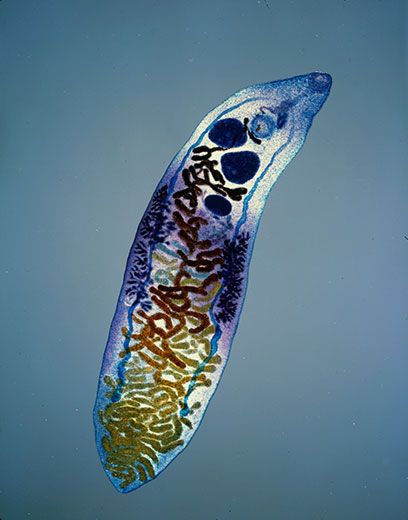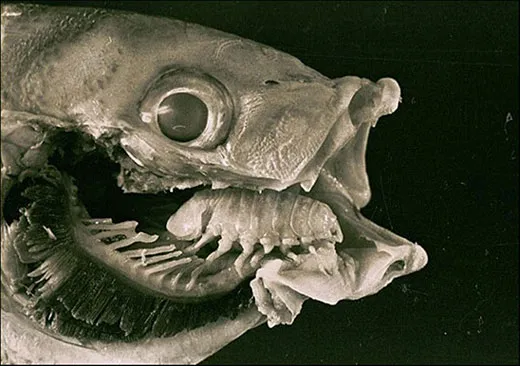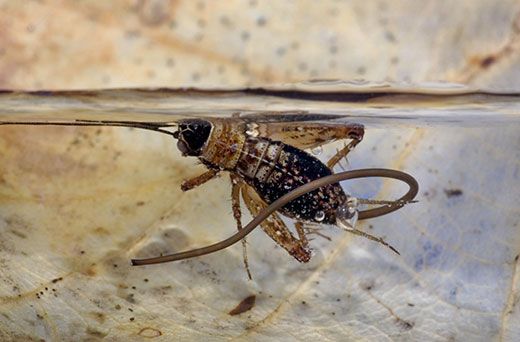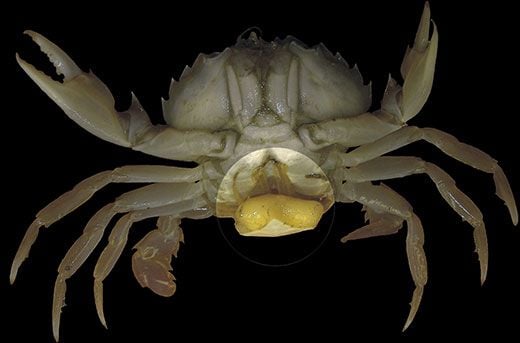Top 10 Real-Life Body Snatchers
Parasites and zombies are not science fiction; they infest rats, crickets, ants, moths and other creatures, sucking the life out of them
/https://tf-cmsv2-smithsonianmag-media.s3.amazonaws.com/filer/parasites-Cymothoa-exigua-631.jpg)
To ensure their own survival, parasites alter the appearance and behavior of their hosts in the creepiest ways. For instance, rats carrying the parasitic protozoan Toxoplasma gondii, which reproduces inside the gut of a cat, no longer fear the smell of cat urine. In fact, they are sexually attracted to the scent, according to a recent study. This way, infected rats walk right into the grips of a feline.
Here are ten other parasites whose sophisticated manipulations of animals are more horrifying than fiction.
1. Paragordius tricuspidatus
Exactly how a hairworm parasitizes a cricket is unknown. Scientists suspect that the insect ingests either an infected mosquito or water containing hairworm larvae. But once inside, the hairworm grows three to four times as long as the arthropod, filling all parts of its body except the head and legs.
What happens next is even more bizarre. The parasite, Paragordius tricuspidatus, produces proteins that hijack the cricket’s central nervous system, making it attracted to areas brighter than its shaded forest home. The cricket, Nemobius sylvestris, heads then to an exposed pond or river and dives in, at which point the hairworm emerges from its host’s rear end. In an aquatic environment, the worm can find a mate and reproduce.
For some crickets, it’s a suicide leap. But others lucky enough not to have drowned have lived for several months after the parasite removes itself. In fact, the crickets’ strange attraction to light subsides as little as 20 hours later.
2. Hymenoepimecis argyraphaga
One of the most complex manipulations of a host by a parasite happens in Costa Rica. A female parasitic wasp of the species Hymenoepimecis argyraphaga stings the spider Plesiometa argyra and paralyzes it. In the 10 to 15 minutes that the spider is immobilized, the wasp lays an egg and affixes it to the spider’s abdomen. For a week or two, the spider proceeds living as normal. Then, the egg hatches. The larva pierces the spider’s tough skin and sucks its blood for sustenance. On the night it plans to kill its host, the wasp larva injects a chemical into the spider that drugs it into spinning a web unlike any it would normally make. Basically, the spider repeats one stitch in its web-constructing repertoire over and over. The wasp larva then kills and eats the spider, spins a cocoon from the sturdy web and, a week and a half later, transforms into a wasp.
3. Glyptapanteles sp.
Little do caterpillars of the moth Thyrinteina leucocerae know, but as they feed on guava and eucalyptus trees in Brazil, the larvae of parasitic wasps of the genus Glyptapanteles may very well be feeding on them. The wasp deposits up to 80 eggs in the caterpillar. When the eggs hatch, the larvae bulk up by eating the host’s innards. At full size, all but a few squeeze through holes in the caterpillar’s skin and spin a cocoon on a nearby twig or leaf.
The larvae that stay behind begin to pull the puppet strings, so to speak. Within a day, the caterpillar stops eating and starts exhibiting a strange behavior—what scientists call “violent head-swings.” Like a bouncer at a bar, it swings at any predators that approach the cocoon, either knocking them down or causing them to back away. Once the wasps emerge, the caterpillar dies, having served its purpose.
4. Sacculina carcini
A parasitic barnacle, Sacculina carcini invades crabs and turns them into surrogate mothers. In the larval stage, female Sacculina swimming in seawater are able to sniff out crabs. They tend to latch onto European green crabs, an invasive species native to the northeast Atlantic. Once the parasite lands on a crab, it makes its way to a joint in the crustacean’s exoskeleton. The barnacle sheds a good portion of its body and, slim as a slug, slips into the hole at the base of one of the crab’s hairs. The parasite travels to the tail end of the crab, where it camps out. The Sacculina grows tendrils that wrap like vines around the inside of the crab, and it pilfers nutrients from the crab’s blood. If a male barnacle locates the bulge on the crab’s underside where the female resides, he too squeezes in and fertilizes the female’s eggs.
Crabs infected with Sacculina are essentially sterilized by it. But since the parasite’s eggs sit in the same place where the crab would carry an egg pouch, the crab cares for them as if they were its own. Even if the crab is a male, it takes on the maternal role. When the larvae have developed enough to exist on their own, the crab goes to a high rock, where it bobs up and down as it pushes the Sacculina larvae out. The crab flails its claws in the water to spread the parasite, as it would its own young.
5. Polymorphus paradoxus
Pond- and river-dwelling crustaceans called Gammarus lacustris typically dart deep into the water, away from light, when ducks are at the surface. But when the crustaceans are infected with Polymorphus paradoxus, a type of thorny-headed worm, they practically throw themselves at their predators. Oddly attracted to light, the parasitized crustacean swims to the surface and clings to a rock or plant. There, fully exposed, the crustacean is more likely to get eaten by a duck. Inside a duck is exactly where the parasite needs to be to reach adulthood. The clinging position of the crab on the rock is the same one that the male crustacean takes while copulating. Scientists speculate that the parasite increases serotonin levels in the crustacean, perhaps making it think it is having sex.
6. Dinocampus coccinellae
A female parasitic wasp of the species Dinocampus coccinellae surreptitiously lays one egg in the abdomen of the ladybug Coleomegilla maculata. Like many parasites, the wasp larva munches on the ladybug’s tissues. Once it reaches a particular stage in its growth, the maggot-like larva inches its way out between segments of the ladybug’s underside. As it does, scientists suspect the larva leaves venoms behind that subsequently alter the ladybug’s behavior. Stunned into a zombie-like state, the ladybug provides cover for a cocoon that the larva spins between the bug’s legs.
After the adult wasp emerges from the cocoon, about 25 percent of ladybugs actually recover from the trauma. Scientists were surprised to find that there is a cost to the parasite: The longer the ladybug guards the cocoon, the less fertile the emerging wasp will be.
7. Dicrocoelium dendriticum
One of the most active hitchhikers has to be a lancet fluke, or flatworm, called Dicrocoelium dendriticum. During its life cycle, the parasite lives in three hosts. First, a snail eats cow dung rife with the worm’s eggs. The eggs hatch inside the snail, and in defense, the snail produces a slime that entraps the larvae. Eventually, the snail hocks a slimy, larvae-filled loogie. Then, an ant comes along and slurps up the slime. The parasites set up two outposts, one around the nerves that control the ant’s mandibles and another in its head. Here is where it gets tricky. The parasite needs to spend its adulthood in the liver of a cow, so it has to get a cow—an herbivore—to eat the ant it has infected. With a little mind control, the parasite gets the ant to crawl up to the top of a blade of grass each night and bite down to stay in place. This way, a cow is more likely to chomp on it while grazing. In the cow’s liver, adult worms reproduce, and the cow later defecates the eggs. And so, the cycle, cleverly illustrated by Matthew Inman on his website The Oatmeal, continues.
8. Leucochloridium paradoxum
Another parasitic flatworm, Leucochloridium paradoxum, infects a snail and then somehow has to get from a snail to a bird, its next and final host. One problem: Birds do not normally snack on snails. Undeterred, the parasite packs itself into the snail’s translucent eyestalks. The green and brown-striped worms make the eyestalks, at least to a bird, look like juicy, quivering caterpillars. Infected snails also make themselves more visible to birds because they do not shy away from light as healthy ones do.
9. Myrmeconema neotropicum
In 2005, scientists at the Smithsonian Tropical Research Institute in Panama studying Cephalotes atratus, a species of tropical ant found in tree canopies, discovered a few ants with bright red gasters. A “gaster” is the last bulb of an insect’s abdomen. Could it be a new species? At least one biologist thought so—enough to bet on it over beers. But when they dissected the ants, the researchers found that the gasters were filled with eggs, each containing a tiny nematode worm.
Foraging ants unknowingly feed the parasite, named Myrmeconema neotropicum, to ant larva via bird feces. The worms then mate inside the grown ant’s abdomen, which fills with yellow eggs. The parasite thins the ant’s exoskeleton, and the eggs change the gaster’s color from black to red.
Mistaking it for a berry, a fruit-eating bird swoops down and plucks the ant’s egg-filled abdomen, which is ripe for the picking. The parasite weakens the exoskeleton between an ant’s gaster and postpetiole, another of its body regions, making ie easier for the bird to detach it. The bird then spreads the worm eggs in its droppings.
10. Cymothoa exigua
The crustacean Cymothoa exigua does not alter the behavior of its host, a snapper of the species Lutjanus guttatus, but it is the first known parasite to functionally replace an entire organ of an animal. The louse is a tongue snatcher. Found primarily in the Gulf of California, the parasite invades a snapper through its gills and hooks seven pairs of claws at the base of the fish’s tongue. It sucks blood from the tongue, and as the parasite grows, the tongue atrophies. By the time the host’s tongue is a nub the parasite becomes a stand-in. The snapper can carry on eating, and the crustacean is there to catch the crumbs.
/https://tf-cmsv2-smithsonianmag-media.s3.amazonaws.com/accounts/headshot/megan.png)




/https://tf-cmsv2-smithsonianmag-media.s3.amazonaws.com/accounts/headshot/megan.png)